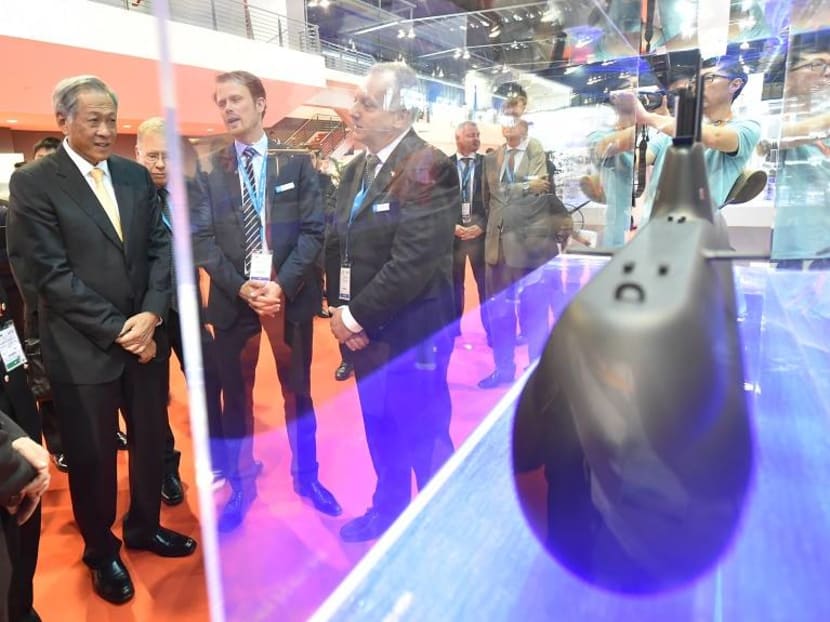Singapore to buy two more German-made submarines
SINGAPORE — Two more German-made Type-218SG submarines will join the Republic of Singapore Navy’s (RSN) fleet from 2024 against the backdrop of a regional naval expansion, Defence Minister Ng Eng Hen announced at the International Maritime Defence Exhibition on Tuesday (May 16).

Dr Ng (left) viewing a model of the Type 218SG submarine at the Thyssenkrupp Marine Systems booth in IMDEX Asia. The two new submarines are expected to arrive in Singapore from 2024. Photo: MINDEF via Facebook
SINGAPORE — Two more German-made Type-218SG submarines will join the Republic of Singapore Navy’s (RSN) fleet from 2024 against the backdrop of a regional naval expansion, Defence Minister Ng Eng Hen announced at the International Maritime Defence Exhibition on Tuesday (May 16).
As maritime trade in Asia-Pacific grows, regional countries have all increased the strength of their navies, Dr Ng noted, with naval budgets in the region expected to increase by 60 per cent through 2020.
It is in this environment that the RSN has to keep pace with the modernisation and growth of navies in Asia, he said.
The latest additions will bring the total number of Type-218SG submarines in the RSN fleet to four.
“In addition to the two previously announced, the RSN will acquire two more Type-218SG submarines to replace its older submarines, with an expected delivery from 2024 onwards,” Dr Ng announced to an audience of leaders from the defence establishment and armed forces chiefs.
“At steady state, the four Type-218SGs in service will complement each other in maintenance, logistics and operations, and have better capabilities to protect our SLOCs (sea lines of communications).”
According to AMI International, there will be approximately 800 more warships and submarines operating within the Asia-Pacific region by 2030, compared with present times.
The acquisition of the first two Type-218SG submarines was announced in 2013, and are expected to be delivered in 2021 and 2022,
respectively.
Built by German multinational conglomerate ThyssenKrupp AG, the Type-218SG submarine contract includes a logistics package and a training arrangement for RSN submarine crew in Germany.
The RSN currently has four Swedish-made vessels from two classes of submarines, the Challenger-class and Archer-class. The two existing Challenger-class submarines are expected to be retired in the next few years, with the four Type-218SG submarines to replace them.
Singapore has one of the largest fleets of submarines in the region. The RSN has been ramping up its underwater capabilities recently, such as via the acquisition of submarine rescue vessel MV Swift Rescue in 2008, and the establishment of a new submarine training centre in 2015.
“It’s necessary to plan ahead in order to maintain a functional, instead of a token, force of submarines,” said Dr Collin Koh, a research fellow in the RSIS maritime security programme. As a small country, Singapore has to “project credible, convincing deterrent capabilities and submarines to provide this by their very inherent characteristics such as stealth especially”, he added.
Dr Graham Ong-Webb, who conducts research in areas which include security issues in the Asia-Pacific, stressed the need for a country’s naval force to be equipped with a range of assets. Adding that naval requirements differ from country to country,
Dr Ong-Webb said that the RSN punches above its weight in terms of having the “cutting-edge capabilities and world class personnel”.
In the region, Indonesia’s navy is “quantitatively larger”, he said. Nevertheless, Singapore is not in an arms race and like other nations, it has to upgrade its systems over time, he added.
Dr Koh noted that Singapore’s navy “started out humbly with second-hand boats”. “(The RSN’s submarine fleet) may not be the largest of all in South-east Asia, but it’ll no doubt be one of the most advanced and professional, and Singapore would likely be in a better position than some of our neighbours in sustaining it,” he said. ADDITIONAL REPORTING KENNETH CHENG






